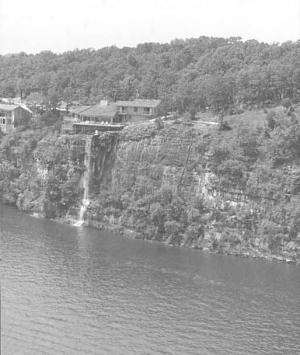They Created Their Own Waterfall
 ✖  |
Floyd and Sharon Anderson, Kansas City, Mo., have a vacation home on the shore-line of Lake of the Ozarks near Sunrise Beach, Mo. The house sits on a 110-ft. bluff overlooking the lake and one day it occurred to them that the bluff would be the perfect spot for a waterfall.
There was only one problem. Most waterfalls are created by a river or stream and. they didn't have one of those. So they de cided to create their own.
What they did was to set up a 1,000 gal. per minute pump on a ledge about 10 ft. above the water. It forces water up a 6-in. line to a fountain on top of the bluff. The water then runs down a 10-ft. spillway and falls back into the lake.
The Andersons say the sound of the falling water has added a lot of pleasure to their rural hidaway. They only "run" the water-fall when they're at the lake. At other times, they shut it down.
The pump that brings power up the bluff is powered by a 3-phase 35-hp. electric motor. Since the area where the vacation house is located is served only by single phase electric power, they had to find a way to get the power they needed. Since it costs as much as $40,000 per mile to bring in 3-phase power, they had to find a less expensive alternative.
The answer was an electric phase converter from Ronk Electrical Industries, Nokomis, Ill. (ph toll-free 1-800-221-RONK). The converter takes conventional single phase power and converts it to 3-phase power for operating standard 3-phase motors. In addition to applications like the Anderson's waterfall, the converters are also widely used by farmers to run grain dryers, compressors, irrigation pumps, or other equipment
Work on the Anderson's waterfall was done by Osage Builders, Inc., Osage Beach, Mo. (ph 314 348-2575).

Click here to download page story appeared in.
Click here to read entire issue
They Created Their Own Waterfall AG WORLD Ag World 19-6-22 Floyd and Sharon Anderson, Kansas City, Mo., have a vacation home on the shore-line of Lake of the Ozarks near Sunrise Beach, Mo. The house sits on a 110-ft. bluff overlooking the lake and one day it occurred to them that the bluff would be the perfect spot for a waterfall.
There was only one problem. Most waterfalls are created by a river or stream and. they didn't have one of those. So they de cided to create their own.
What they did was to set up a 1,000 gal. per minute pump on a ledge about 10 ft. above the water. It forces water up a 6-in. line to a fountain on top of the bluff. The water then runs down a 10-ft. spillway and falls back into the lake.
The Andersons say the sound of the falling water has added a lot of pleasure to their rural hidaway. They only "run" the water-fall when they're at the lake. At other times, they shut it down.
The pump that brings power up the bluff is powered by a 3-phase 35-hp. electric motor. Since the area where the vacation house is located is served only by single phase electric power, they had to find a way to get the power they needed. Since it costs as much as $40,000 per mile to bring in 3-phase power, they had to find a less expensive alternative.
The answer was an electric phase converter from Ronk Electrical Industries, Nokomis, Ill. (ph toll-free 1-800-221-RONK). The converter takes conventional single phase power and converts it to 3-phase power for operating standard 3-phase motors. In addition to applications like the Anderson's waterfall, the converters are also widely used by farmers to run grain dryers, compressors, irrigation pumps, or other equipment
Work on the Anderson's waterfall was done by Osage Builders, Inc., Osage Beach, Mo. (ph 314 348-2575).
To read the rest of this story, download this issue below or click
here to register with your account number.







